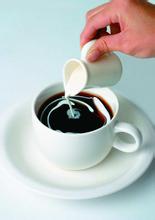Three primary coffee beans
Three native beans of coffee
Arabica species (arabica): the origin of Ethiopia, equivalent to the rich and handsome coffee beans, is a precious coffee bean species. It is planted at an altitude of 700-2000 meters, accounting for 75-80% of the world coffee production. It has excellent flavor and aroma, low caffeine content, about 1-1.5% of its weight, but low resistance to dryness, frost, diseases and insect pests. It is the bean source of boutique coffee. The main producing areas are South America, Central America, East Africa and Southeast Asia.
Robusta species (robusta): of African origin, Congo. It grows at lower altitude, has strong resistance to diseases and insect pests, and can also grow in a poor environment with high temperature and humidity. It has a unique "Rob" flavor, which helps to increase the concentration and weight of the coffee. The caffeine content is higher, the caffeine content is 2% Murray 3.5, the price is lower. It is generally used in instant coffee, canned coffee, commercial blended coffee and so on. The main producing areas are Indonesia, Vietnam and West African countries.
Liberian species (liberica): originating in West Africa. Whether high or low temperature or wet, dry, can grow, not resistant to leaf rust, poor flavor. At present, the market is very rare, only in some West African countries.

Important Notice :
前街咖啡 FrontStreet Coffee has moved to new addredd:
FrontStreet Coffee Address: 315,Donghua East Road,GuangZhou
Tel:020 38364473
- Prev

Defective beans-a fatal wound in the taste of coffee
The grapes produced on the same vine may not necessarily have a sweet and sour taste, not every grape may have a good appearance and consistent maturity, some may have been bitten by insects, some may be stunted, and so on. This is a normal phenomenon, and so is coffee. The raw coffee beans obtained from the treated coffee fruits are not always good.
- Next

Effect of steaming on coffee brewing
Last time we used the Smart Cup to get objective data on whether it was steaming or not and how long it lasted. Learn from the senses that with the increase of steaming time, the acidity decreases, and the sense of sweetness and stickiness increases. The overall flavor gradually moved backward, and more complex. From the display on TDS and EXT, we know that with the increase of steaming time, the values of TDS and EXT show a downward trend. And I.
Related
- Beginners will see the "Coffee pull flower" guide!
- What is the difference between ice blog purified milk and ordinary milk coffee?
- Why is the Philippines the largest producer of crops in Liberia?
- For coffee extraction, should the fine powder be retained?
- How does extracted espresso fill pressed powder? How much strength does it take to press the powder?
- How to make jasmine cold extract coffee? Is the jasmine + latte good?
- Will this little toy really make the coffee taste better? How does Lily Drip affect coffee extraction?
- Will the action of slapping the filter cup also affect coffee extraction?
- What's the difference between powder-to-water ratio and powder-to-liquid ratio?
- What is the Ethiopian local species? What does it have to do with Heirloom native species?

